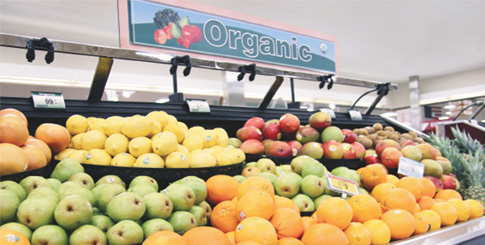From juice bars to superfoods, fruits and vegetables are trending. Consumers, especially millennials, are seeking out more organic foods. Manufacturers, retailers, and restauranteurs have taken notice, and organics are riding the crest of a growing wave toward healthy alternatives. Snacks offered today include pulse-based crackers and chips infused with beets, spinach, and other vegetables.
Wider Availability
Once only the domain of natural food stores, community supported agriculture groups, and farmers’ markets, fresh organic produce can be found in big-box retailers and conventional grocers—where half of all organic food is now sold—as well as even convenience stores. Amid the country’s retailers, club chain Costco is the largest seller of organics, having cornered about 10 percent of the U.S. market.
It will come as no surprise that California leads the nation in organic sales by a wide margin, followed by Washington state, then a mix of states including Pennsylvania, Oregon, Wisconsin, Texas, New York, Colorado, Michigan, and Iowa. These states combined are responsible for three-quarters of all organic sales in the United States.
What might surprise some suppliers and consumers are the top produce-themed organic bestsellers in terms of weekly retail dollar sales. In a review of 2016’s top ten products, bagged salad mixes were number-one according to United Fresh Produce Association’s “FreshFacts” report compiled by
Chicago, IL-based Nielsen Perishables Group. Next came berries; apples; herbs, spices, and seasonings; carrots; then blended beverages; bananas; various value-added vegetable products; lettuce; and finally, tomatoes.
“Organics continue to be a growth opportunity for many produce commodities and are now a valued part of most retail programs,” confirms Tom Stenzel, president and CEO of the United Fresh Produce Association. “Produce marketers are now able to offer consumers choices in both conventional and organic produce to ensure we’re meeting demand and growing consumption overall.”
Restaurateurs are also stepping up to the plate. A 2016 National Restaurant Association survey reported that 71 percent of fine dining, 46 percent of casual dining, 35 percent of fast casual, 33 percent of quick service, and 29 percent of family dining restaurant operators “offer food grown or raised in an organic or environmentally sustainable way.”
Supply Growing, Demand Growing Faster
Today, there are nearly 22,000 certified organic operations in the United States and about 2,000 in transition. Although organics represent just 5 percent of all food sold in the country, and 10 percent of produce dollars, demand continues to outpace production.



